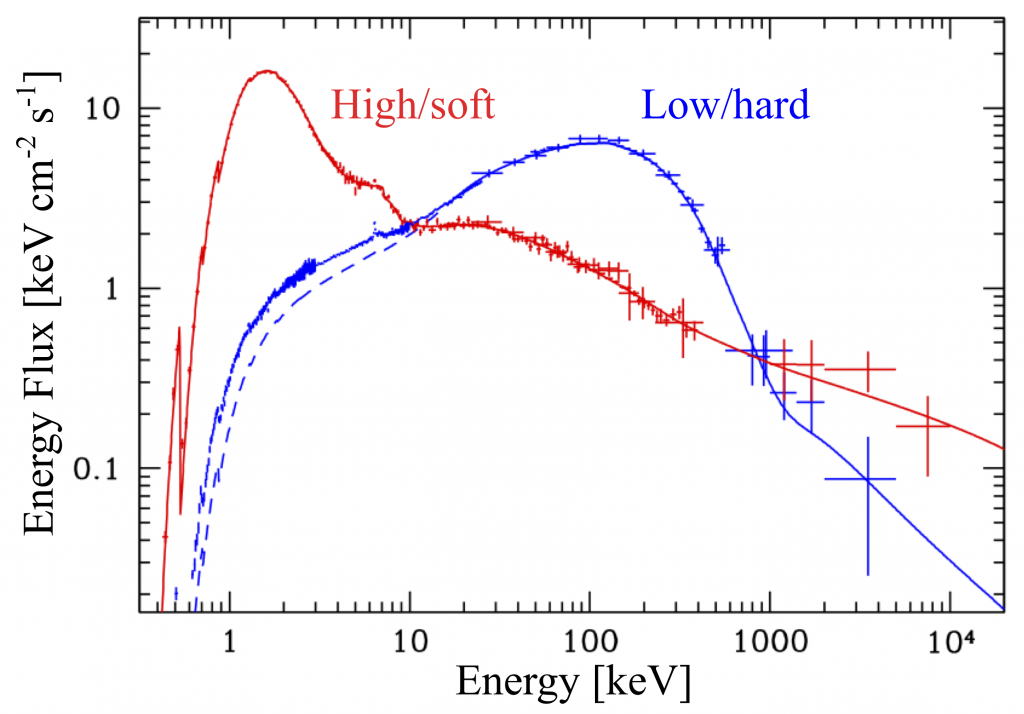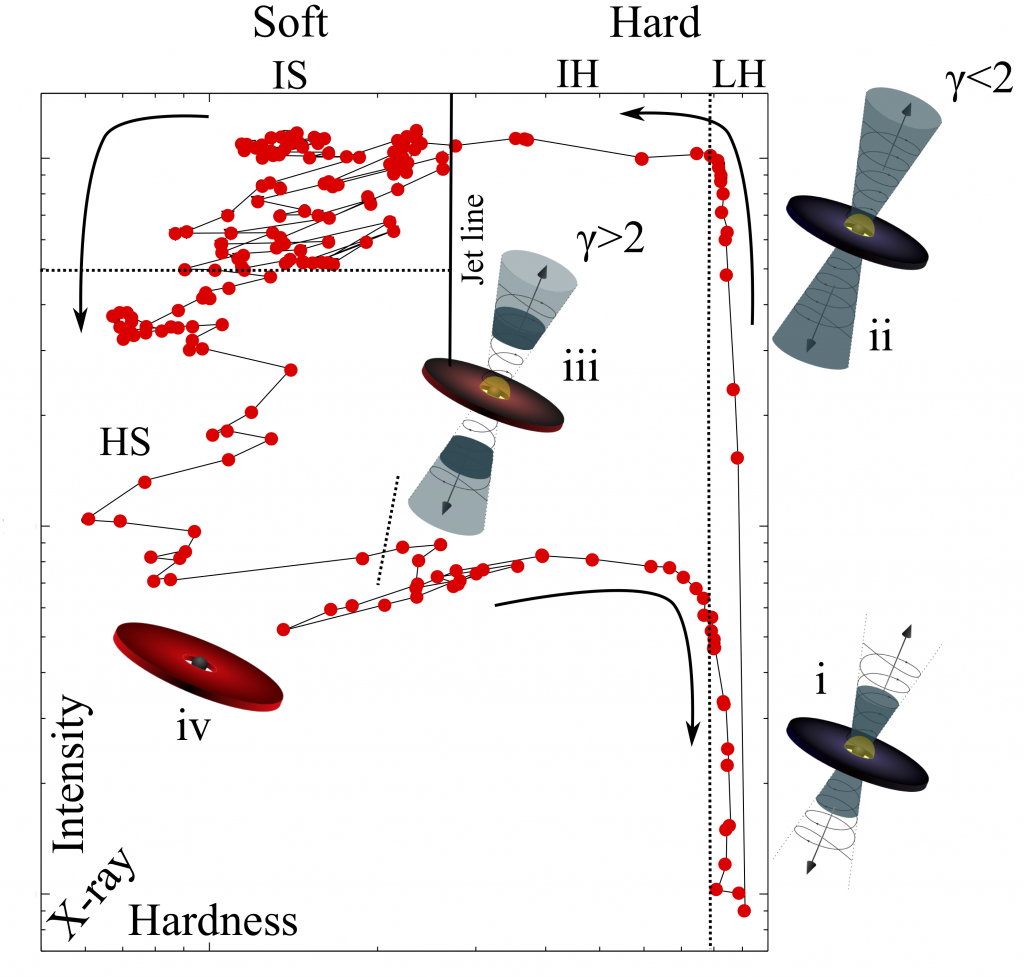X-ray binaries

Introduction
X-ray binaries are double star systems consisting of a compact object (essentially either a neutron star or a black hole) and usually a non-degenerate companion (i.e. any star that is fusing its hydrogen and helium reservoir). The crux to forming an X-ray binary is the transportation of matter from the companion star to the compact object. This transportation occurs in either of two fashions: the stars orbit each other closely enough so that their gravitational potentials overlap thus allowing for the leakage of matter from the companion to the compact object or the companion’s stellar wind powers an outflow of matter which is then partly captured by the compact object. In both cases, due to the different rotations present in the binary (e.g. the rotation of the companion itself and the rotation of the companion around the compact object), the matter flowing toward the compact object possesses intrinsic angular momentum. Therefore, the matter does not fall directly into the compact object (or onto, for a neutron star primary) but instead starts to orbit it, and would orbit if forever if not for some mechanism that transports the angular momentum away thus causing the matter to fall ever closer to the compact object, until it eventually falls into it. The transportation of the angular momentum coupled with the rotation of the system and gravitational pull of the compact object generates a disk-like structure around the compact object referred to as an accretion disk.
Accretion disks are observed throughout the universe around a plethora of objects from active galactic nuclei to protoplanetary systems. Apart from the other accretion disk structures in the universe, the fact that neutron stars and black holes are physically very small in size (tens of kilometers) allows the accretion disk in X-ray binaries to attain very small radii and hence the matter acquires substantial gravitational energy before plunging into or onto the compact object. This energy must then be radiated away before coming to a full stop on the surface of a neutron star or, as in the case of black holes, a fraction can also be advected inside the event horizon, therefore reducing the radiation requirement. By and large, the current consensus for accretion disk angular momentum transportation is in the form of molecular viscosity and magnetic tension acting on adjacent Keplerian radii. In a given radius, the Keplerian orbital velocity is slightly larger and slightly slower than the orbital velocities of the next radius further away and closer to the compact object, respectively. Therefore, the adjacent fluid elements in the disk experience velocity shear which causes turbulent viscosity between the elements extracting and dissipating gravitational energy which in turn heats up the disk. The adjacent elements are also magnetically connected (the magnetic field is “frozen” in the disk), and the velocity shear in the disk causes the magnetic tension to increase between the elements which decrease the angular momentum of the inner and increases the angular momentum of the outer element. The accretion process turns out to be very effective at extracting gravitational energy and the majority of the resulting thermal radiation is released very close to the black hole or neutron star and is emitted in the form of X-rays. It is due to this radiation that we can tap into the extreme environment just outside the event horizons of black holes.
 X-ray binaries have been on the observing lists of astronomers from the early days of space-based X-ray instruments. Starting with the late 1940s, the sky was scanned for mere minutes at a time with Geiger counters placed inside the nozzles of sounding rockets. By the 1970s, the era of satellite missions had arrived. It was indeed the rocket missions of the 1960s that first spotted X-rays from celestial sources other than the Sun. These anomalous X-ray objects in our Galaxy were given names according to the constellations in which they were found and numbers according to the running number of sources in each constellation, for example Scorpius X-1 and Cygnus X-3. To this date, tens of X-ray observatories have flown and the number of X-ray binaries has risen to hundreds (the previous naming scheme long forgotten and replaced by catalogue- and coordinate-based one, for example MAXI J1820+070).
X-ray binaries have been on the observing lists of astronomers from the early days of space-based X-ray instruments. Starting with the late 1940s, the sky was scanned for mere minutes at a time with Geiger counters placed inside the nozzles of sounding rockets. By the 1970s, the era of satellite missions had arrived. It was indeed the rocket missions of the 1960s that first spotted X-rays from celestial sources other than the Sun. These anomalous X-ray objects in our Galaxy were given names according to the constellations in which they were found and numbers according to the running number of sources in each constellation, for example Scorpius X-1 and Cygnus X-3. To this date, tens of X-ray observatories have flown and the number of X-ray binaries has risen to hundreds (the previous naming scheme long forgotten and replaced by catalogue- and coordinate-based one, for example MAXI J1820+070).
In addition to X-ray wavelengths, X-ray binaries emit radiation at other wavelengths, most notably in the radio band. The scientific consensus is that this radiation arises from relativistic electrons circling around magnetic field lines and thus radiating synchrotron radiation. The origin of this synchrotron radiation is linked to a highly collimated outflow of plasma that has been seen emanating from extragalactic quasars. Microquasars, dubbed as such because of their similar phenomenological (and physical, albeit scaled down) appearance to extragalactic quasars, are X-ray binaries with resolved, relativistic jets emanating from the central source, that includes the accretion disk. These jets are tightly linked to the accretion process, albeit exactly how is a very important question and is still debated among scientists. However, the prevailing view is that the jets are launched due to an interplay between a strong vertical magnetic field and the rotation of the accretion disk and/or the black hole. Thus, microquasars provide ample opportunity to study the connection between the inflow of matter toward the compact object and the subsequent outflow of matter into the relativistic jets.
Radiation from X-ray binaries
Soon after the discovery of X-ray binaries they were found to be highly variable in the X-ray band from 1 to 10 keV (Tananbaum et al. 1972), varying from a low luminosity state to a high luminosity state. Often these states are referred to as “the low state” and “the high state” (e.g. van der Klis 1994; Nowak 1995; McClintock and Remillard 2006). However, one has to bear in mind that these labels were assigned in order to explain the source behavior in this relatively narrow band.

The high state X-ray spectrum was found to be dominated by a blackbody-like, curved component, which can be attributed to emission arising from the accretion disk. In this case, most of the emitted bolometric luminosity is concentrated on photon energies below 10 keV resulting in a “soft” spectrum. On the other hand, the low state X-ray spectrum is dominated by a power law-like component which extends beyond 10 keV. This component is taken to represent the inverse Comptonization of soft seed photons in a plasma cloud of hot electrons. In a Compton scattering event, a photon hits an electron moving at arbitrary speed. This interaction results in an energy exchange for the photon and electron leaving the scattering site. In astrophysical plasmas the electrons are normally highly relativistic. In this case the photons can acquire energy that is many times its initial energy. In the low state, the coronal component in the source dominates, and the disk is either greatly reduced or then immersed inside the corona resulting in a “hard” spectrum where the bolometric luminosity is concentrated on photon energies above 10 keV. This spectral bimodality has been added to the state vocabulary so that the high state becomes the high/soft (HS) state and the low state the low/hard (LH) state. These states are usually referred to as the canonical X-ray states of X-ray binaries. In addition to the canonical states, X-ray binaries exhibit various transition or intermediate states in between the HS and LH states. These intermediate states are by virtue much more rare and transitionary but they convey important information on the relationship between the two canonical spectral components in X-ray binaries.
The common view is that there is a change in the rate at which matter flows from the companion star to the accretion disk that ultimately drives the spectral evolution. An important limit is set when considering the radiation pressure gradient from the intense X-ray radiation near the ISCO and the gravitational pressure gradient of the inflowing matter. The limit where the radiation pressure gradient becomes equal to the gravitational pressure gradient, therefore stalling the accretion of matter toward the compact object, is called the Eddington luminosity or Eddington limit, and it was originally derived for stars (spherically symmetric objects), but it can be used to approximate the behavior of accretion disks as well. When the accretion rate is high (close to the Eddington luminosity) the material in the accretion disk pushes close to the compact object and radiates predominantly thermal, blackbody radiation driving the system into the HS state by cooling the hot electrons via Coulomb collisions and Compton scattering. On the other hand, when the accretion rate is low the inflow toward the compact object is much reduced and the Coulomb coupling between protons and electrons is weak. This in turn leads to diminished radiation and drives the system into the LH state, as most of the heat is contained in protons, which do not radiate, and energy transfer to the electrons is inefficient.
Jets from X-ray binaries
However, the X-ray emission is only a half of the story. The jets observed from XRBs are very highly collimated and as they propagate through the interstellar medium at relativistic speeds, they harbor a huge amount of kinetic energy. There are two important observations which tell us that the jets could emanate from deep within the potential well of the accreting compact object and, therefore, are closely related to the accretion process itself. First, the speed of the jet is of the order of the escape velocity from the vicinity of the compact object. For example, the jets observed from the black hole candidate GRS 1915+105 move with a speed of 92% of the speed of light (Mirabel and Rodríguez 1994) which corresponds to the escape velocity at a distance of 2.4 gravitational radii from the compact object. Secondly, the jet ejection takes place during the state transition from the LH state to the HS state, and indicates a relationship between the jet and the accretion disk. This is often accompanied by the temporary disappearance of the hard X-ray emission which indicates the cessation of hard X-ray production in the corona.
 Though it is clear that the black hole systems produce energetic and relativistic jets, they present a difficulty for the electromagnetic theory of jet production: black holes cannot support a magnetic field. The only way for supporting such a magnetic field is that the current generating the magnetic flux comes from an external supply of plasma, i.e. the accretion flow. On the other hand, accretion flows are believed to be weakly-magnetized plasmas in highly turbulent, rotating flows around the black hole (Balbus and Hawley 1998). Thus, managing a well-behaving, global and rotating magnetosphere with this turbulent accretion disk is a tricky problem. The leading model for producing this kind of phenomenon is called the magnetohydrodynamic (MHD) accelerator model which was originally proposed by Lovelace (1976) and Blandford (1976). Briefly, it uses energy from the differential rotation of the accretion disk coupled with a strong electromagnetic field to convert rotational kinetic energy into kinetic energy of a jet. A magnetic pressure gradient lifts the plasma out of the gravitational potential well and the pinch effect collimates the outflow into a jet. However, there are observational reasons for believing that the same source may produce jets of different speeds, either simultaneously or in different accretion states. Similarly, there are multiple theories for producing jet launching in the same black hole system. Two models that may be driving XRBs are known as the Blandford-Payne (Blandford and Payne 1982) and the Blandford-Znajek (Blandford and Znajek 1977) mechanisms. The former uses only Newtonian mechanics to drive axially-oriented outflows from the disk and the latter concerns the vicinity of the compact object and how in this region the magnetic field lines are forced, by the rotation of the disk, to spin. The spinning field lines will assume an outward spiraling shape and centrifugal forces will fling out the magnetically frozen plasma along the field lines to form two magnetized jets. The toroidal magnetic field will pinch the plasma towards the jet axis that provides self-collimation to the jets. It is also possible to extract energy from the spin of the black hole to drive the jet and achieve more energetic outflows (Punsly and Coroniti 1990). Supporting observations exists that show that the jet energies in the black hole systems are indeed ∼30 times stronger than the jet energies in the neutron star systems with similar accretion rates (Migliari et al. 2003).
Though it is clear that the black hole systems produce energetic and relativistic jets, they present a difficulty for the electromagnetic theory of jet production: black holes cannot support a magnetic field. The only way for supporting such a magnetic field is that the current generating the magnetic flux comes from an external supply of plasma, i.e. the accretion flow. On the other hand, accretion flows are believed to be weakly-magnetized plasmas in highly turbulent, rotating flows around the black hole (Balbus and Hawley 1998). Thus, managing a well-behaving, global and rotating magnetosphere with this turbulent accretion disk is a tricky problem. The leading model for producing this kind of phenomenon is called the magnetohydrodynamic (MHD) accelerator model which was originally proposed by Lovelace (1976) and Blandford (1976). Briefly, it uses energy from the differential rotation of the accretion disk coupled with a strong electromagnetic field to convert rotational kinetic energy into kinetic energy of a jet. A magnetic pressure gradient lifts the plasma out of the gravitational potential well and the pinch effect collimates the outflow into a jet. However, there are observational reasons for believing that the same source may produce jets of different speeds, either simultaneously or in different accretion states. Similarly, there are multiple theories for producing jet launching in the same black hole system. Two models that may be driving XRBs are known as the Blandford-Payne (Blandford and Payne 1982) and the Blandford-Znajek (Blandford and Znajek 1977) mechanisms. The former uses only Newtonian mechanics to drive axially-oriented outflows from the disk and the latter concerns the vicinity of the compact object and how in this region the magnetic field lines are forced, by the rotation of the disk, to spin. The spinning field lines will assume an outward spiraling shape and centrifugal forces will fling out the magnetically frozen plasma along the field lines to form two magnetized jets. The toroidal magnetic field will pinch the plasma towards the jet axis that provides self-collimation to the jets. It is also possible to extract energy from the spin of the black hole to drive the jet and achieve more energetic outflows (Punsly and Coroniti 1990). Supporting observations exists that show that the jet energies in the black hole systems are indeed ∼30 times stronger than the jet energies in the neutron star systems with similar accretion rates (Migliari et al. 2003).
The jets radiate via synchrotron process which arises from the relativistic motion of charged particles in a magnetic field, and thus is a prominent radiation component in astrophysical plasmas since strong magnetic fields are present in many astrophysical sources. The origin of this radiation is usually due to electrons moving at relativistic speeds, since they are lighter than protons and hence more easily accelerated. The non-relativistic case is referred to as cyclotron radiation. The motion of electrons in the presence of a magnetic field consists of a constant velocity component along a magnetic field line and circular motion around it, i.e. a spiral path with a constant pitch angle. A charged particle spiraling around a magnetic field line is accelerated and emits radiation into a tight radiation cone. The resulting radiation is typically observed in the radio frequencies.
Disk-jet connection in X-ray binaries
The “disk-jet connection” concept consists of studying the relation between the accretion disk (emitting mostly in the X-rays) and the jet (emitting mostly in the radio). In general, many bright XRBs are accompanied during an X-ray outburst by a radio outburst (Fender et al. 2009). Thus, it is apparent that rapid changes in the disk configuration and mass accretion rate that cause X-ray state changes are also coupled with the jet production. In the case of persistent XRBs, like Cyg X-1, the X-ray and radio are correlated during the LH state (e.g. Zdziarski et al. 2011). But when the system transitions from the LH to the HS state, the radio emission quenches abruptly. Again, the state transition is linked to the major changes in the accretion geometry which prevents the jet production (e.g. Tigelaar et al. 2004). Thus, it is the “intermediate state”, often subdivided into multiple (sub-)states, that conveys important information regarding the disk-jet connection, since it lies between the two extreme states. Typically, XRBs follow a similar evolution through the different X-ray spectral states and trace similar tracks in the hardness-intensity diagram (HID, see Figure below). The HID shows the X-ray intensity (i.e. source luminosity not corrected for distance) as a function of hardness ratio (a ratio between the intensities of two spectral bands, usually one for soft X-rays with intensities below 10 keV and one for hard X-rays with intensities above 10 keV). A typical black hole HID representing the transient outbursting cycle has a Q-type shape that can be divided into four main areas or states: quiescent, low/hard, intermediate and high/soft. These areas/states are briefly reviewed in the following:
 Quiescent state (lower right in the diagram): The source flux is very low in both the X-ray and radio with the spectrum described by a hard power law;
Quiescent state (lower right in the diagram): The source flux is very low in both the X-ray and radio with the spectrum described by a hard power law;
Low/hard (LH, right side): The source can be bright in the X-rays and its spectrum is described by a power law with exponential cut-off at ∼ 100 keV. The radio emission has a flat spectrum and appears as a compact jet;
Intermediate (top): As the source moves from the LH state to the intermediate state the radio emission stays steady almost until the point of major ejection in the intermediate/soft (IS) state. However, the radio emission starts to become more variable exhibiting a peaked or optically thin spectrum shortly before the radio flare, which occurs during the state change from the intermediate/hard (IH) state to the IS state. Also, when the source moves in the opposite direction, from the IS to the IH, this often corresponds to optically thin radio outbursts (Fender et al. 2004). Jets during the intermediate states are associated with highly relativistic motion, unlike the steady jets in the LH state which are usually mildly relativistic. This implies that the geometrical change in the disk could cause a more energetic jet than it would otherwise. One scenario to explain this behavior invokes internal shocks. The increase of the X-ray luminosity of the accretion source could result in the increase of the velocity of the outflow. Thus, the more energetic jet (with greater velocity) catches up with ejecta in the jet that were emitted in the LH/IH state and forms shocks. During this state there is a prominent thermal disk component and a steep power law without a cut-off;
High/soft (HS, left side): This state is thermally dominated and typically there is no power law component, or if present, it is very weak. There is also a line that demarcates the intermediate state region from the HS region that is referred to as the jet line. When the source crosses this line going from right to left there is a sudden cut-off of radio emission. It is during this transition that strong radio flares occur.
The overall picture emerging from the disk-jet connection and theoretical studies of jet launching is that in the LH state (phase i in the above figure) the jet is powered by the Blandford-Payne mechanism, i.e. the accretion disk powered jet, resulting in a steady but rather weak jet. On the other hand, as the system transits to intermediate X-ray states the accretion disk propagates inward and the plasma starts to “feel” the compact object and the jet gains more energy via the Blandford-Znajek mechanism. When the disk approaches the ISCO, the bulk velocity of the jet increases rapidly before the jet is suppressed in the HS state. This may occur due to the suppression of the jet launching mechanism or due to a suppression of the radio emission. An example of the former could be a shift in the accretion geometry from a thick disk to a thin disk, which would strongly affect the magnetic field strength driving the jet. An example of the latter could be the interaction of the non-thermal, synchrotron-emitting particles with the strong radiation field of the disk slowing down the relativistic particles and producing thermal jets. Thus, major radio flaring periods are of prime importance for studying the relationship between the accretion disk and the radio jets, using simultaneous radio and X-ray observations.